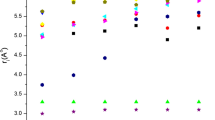Abstract
Salting effects of metal chelate electrolytes Fe(phen)3Br2, Fe(bpy)3Br2, Co(phen)3Br2, Co(phen)3Br3, Co(en)3Br3, and Co(pn)3Br3 (where phen=1,10-phenanthroline, bpy=2,2′-bipyridyl, en=ethylenediamine, and pn=1,2-propylenediamine) on the solubilities of nitrobenzene,o-,m-,and p-dinitrobenzenes (DNB), and toluene were studied in water at 25°C and compared to the results for sodium bromide and tetrabutylammonium bromide (Bu4NBr). The Co(phen) 3+3 , Fe(phen) 2+3 , and Fe(bpy) 2+3 ions showed much stronger salting-in effects than did the Bu4N+ ion, while the effects of the Co(en) 3+3 and Co(pn) 3+3 ions are comparable with those of Bu4N+. A great dependence of salting-in on the polarity of dinitrobenzene isomers was found for Co(phen) 3+3 and Fe(phen) 2+3 . The results were related to the partial molal volume of the respective cations. The very strong salting-in was considered to be mainly due to hydrophobic hydrations of the metal chelate cations and partly due to van der Waals interactions between the aromatic ligands and the nonelectrolytes. The small salting-in effects by Co(en) 3+3 and Co(en) 3+3 were interpreted in terms of hydrogen bonding between oxygen atoms of the nitro compounds or the solvent water molecules and hydrogen atoms attached to nitrogens in the complexes.
Similar content being viewed by others
References
Y. Yamamoto, T. Tarui, E. Iwamoto, and T. Tarumoto,Anal. Chim. Acta 84, 217 (1976).
F. M. Van Meter and H. M. Neumann,J. Am. Chem. Soc. 98, 1382, 1388 (1976).
T. Fujiwara and Y. Yamamoto,Inorg. Nucl. Chem. Lett. 11, 635 (1975).
M. Yamamoto and Y. Yamamoto,Inorg. Nucl. Chem. Lett. 11, 691 (1975).
M. Yamamoto, Y. Uwate, and Y. Yamamoto,Inorg. Nucl. Chem. Lett. 12, 713 (1976).
E. Iwamoto, M. Yamamoto, and Y. Yamamoto,Inorg. Nucl. Chem. Lett. 10, 1069 (1974).
F. A. Long and W. F. McDevit,Chem. Rev. 51, 119 (1952).
A. G. Leiga and J. N. Sarmousakis,J. Phys. Chem. 70, 3544 (1966).
J. E. Desnoyers and F. M. Ichhaporia,Can. J. Chem. 47, 4639 (1969).
W. L. Masterton and R. N. Schwartz,J. Phys. Chem. 69, 1546 (1965).
W. L. Masterton, T. P. Lee, and R. L. Boyington,J. Phys. Chem. 73, 2761 (1965).
W.-Y. Wen and J. H. Hung,J. Phys. Chem. 74, 170 (1970).
S. K. Shoor, R. D. Walker, Jr., and K. E. Gubbins,J. Phys. Chem. 73, 312 (1969).
Y. T. Chang, M. Y. Schrier, and E. E. Schrier,J. Phys. Chem. 78, 165 (1974).
R. Aveyard and R. Heselden,J. Chem. Soc. Faraday Trans. 1 70, 1953 (1974).
A. Feillolay and M. Lucas,J. Phys. Chem. 76, 3068 (1972).
A. Vesala,Acta Chem. Scand., Ser. A 28, 839 (1974); P. M. Gross and J. H. Saylor,J. Am. Chem. Soc. 53, 1744 (1931).
Y. Yamamoto, E. Sumimura, K. Miyoshi, and T. Tominaga,Anal. Chim. Acta 64, 225 (1973).
W.-Y. Wen and S. Saito,J. Phys. Chem. 68, 2639 (1964).
W. F. McDevit and F. A. Long,J. Am. Chem. Soc. 74, 1773 (1952).
J. E. Desnoyers, M. Arel, G. Perron, and C. Jolicoeur,J. Phys. Chem. 73, 3346 (1969).
A. Jensen, F. Basolo, and H. M. Neumann,J. Am. Chem. Soc. 80, 2354 (1958).
Y. Yamamoto, T. Tominaga, and S. Tagashira,Inorg. Nucl. Chem. Lett. 11, 825 (1975).
A. Zalkin, D. H. Templeton, and T. Ueki,Inorg. Chem. 12, 1641 (1973).
B. M. Fung,J. Am. Chem. Soc. 89, 5788 (1967).
I. L. Jenkins and C. B. Monk,J. Chem. Soc., 68 (1951).
P. S. Ramanathan, C. V. Krishnan, and H. L. Friedman,J. Solution Chem. 1, 237 (1972).
B. E. Conway, D. M. Novak, and L. Laliberté,J. Solution Chem. 3, 683 (1974).
K. Semba,Bull. Chem. Soc. Jpn. 34, 722 (1961).
J. O'M. Bockris, J. Bowler-Reed, and J. A. Kitchner,Trans. Faraday Soc. 47, 184 (1951).
E. Iwamoto, T. Tarumoto, T. Tarui, and Y. Yamamoto,Chem. Lett., No. 9, 755 (1972).
Y. Yamamoto and E. Iwamoto, unpublished results.
T. Tarui, E. Iwamoto, and Y. Yamamoto,Inorg. Nucl. Chem. Lett. 11, 323 (1975).
Landolt-Börnstein,Zahlenwerte und Funktionen, Vol. 1, Part 3 (Springer-Verlag, Berlin, 1951), p. 509.
Handbook of Chemistry and Physics (The Chemical Rubber Co., 1966).
B. E. Conway,Electrochemical Data (American Elsevier, New York, 1952).
W. R. Gilkerson and J. L. Stewart,J. Phys. Chem. 65, 1465 (1961).
F. J. Millero,Water and Aqueous Solutions, R. A. Horne, ed. (Wiley, New York, 1972), Chap. 13.
F. Kawaizumi and Y. Miyahara,Nippon Kagaku Zasshi 89, 655 (1968).
Y. Yamamoto, T. Tominaga, and K. Yoshitani, unpublished results.
Author information
Authors and Affiliations
Rights and permissions
About this article
Cite this article
Iwamoto, E., Hiyama, Y. & Yamamoto, Y. Hydrophobic and charge-dipole interactions in aqueous solutions of highly charged metal chelate cations and nitrobenzene, dinitrobenzenes, and toluene at 25°C. J Solution Chem 6, 371–383 (1977). https://doi.org/10.1007/BF00645510
Received:
Revised:
Issue Date:
DOI: https://doi.org/10.1007/BF00645510




